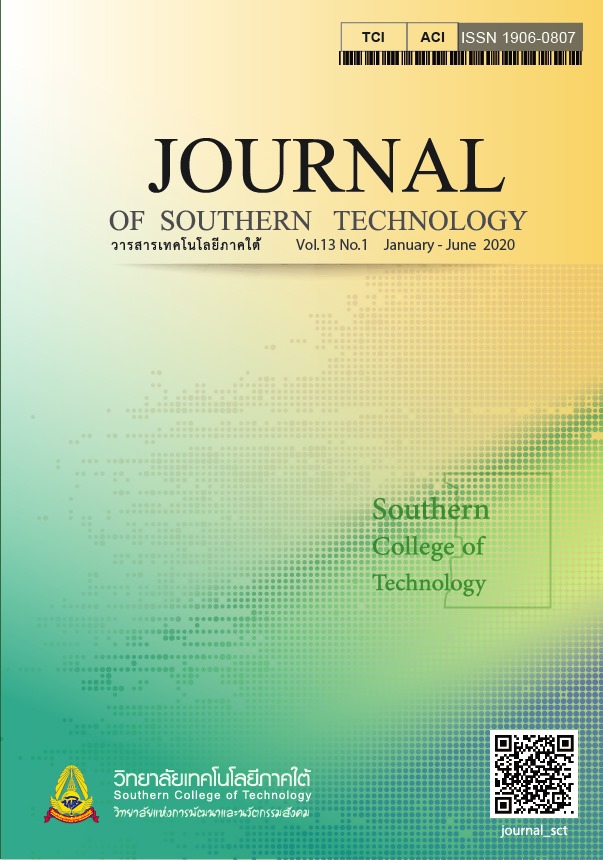Efficacy of Human Resource Systems influence toward Quality of Work Life. Case Study of Game Industry in Thailand.
Main Article Content
Abstract
This research aimed to analyze the relationship between the Efficacy of Human Resource Systems and the quality of work life that lead to finding in-depth information of the predictive correlational between the two factors. The sample was 319 person who’s working within the game industry in Thailand. This research used a sampling method that is convenient and voluntary to provide information to researchers including in-depth interviews of 5 people who are person related to work in the management of people, such as 1) Executives and 2) Human resources manager through selected by purposive sampling. Quantitative data analysis using descriptive statistics including percentage, mean and standard deviation. Inferential statistical analysis contain with Pearson product moment correlation coefficient and stepwise multiple regression analysis. Qualitative data analysis using content analysis. The results of the study showed that (1) the organization has a human resource operation in both HRM and HRD very effective. (2) The personnel in the game industry has a quality of work life at high level. (3) The efficiency of the human resources system in all 9 characteristics is positively correlated with quality of work life at high level. (4) The operations of social responsibility, career development, employee relations, recruitment and selection and compensation and benefits management can be able to jointly predict the variability of overall quality of work life by 76.9 percent. (5) Activities to create quality of work life such as 5.1) selection of people should be consider based on knowledge, skill, work experience and attitude. 5.2) salary, project remuneration, bonus, profit-sharing, medical fee, provident fund and travel expenses. 5.3) providing opportunities for feel free expression of ideas, characteristics of work that focus on teamwork, physical space to do activities. 5.4) challenging job opportunities, job learning and advising from the supervisor, trainee mentor. 5.5) freedom of expression, equality of expression, organization culture and employment conditions that focus on accord with law.
Article Details
-
Authors must agree to the journal publication rules and allow the editors to edit the manuscripts for publication.
-
Author’s right belongs to the author but Journal of Southern Technology holds the right of first publication and thus allow readers to use the article for the purpose of education but not commercial.
References
Eimvimungsa, T., & Wetdapun, K. (2015). Human resource management affecting the quality of working life of staff in Mahidol University. EAU Heritage Journal, 5(1), 275-282.
Hosseini, S. M., Jorjafki, G. M., & Ashrafi, A. M. (2010). Quality of Work Life (QWL) and Its Relationship with Performance. Paper presented at the International Conference Advanced Management Science (ICAMS), 2010 IEEE International Conference.
Koivunen, T., Ylöstalo, H., & Lehtoranta, K. O. (2015). Informal practices of inequality in recruitment in Finland. Nordic Journal of Working Life Studies, 5(3), 3-18.
Krejcie, R. V., & Morgan, D. W. (1970). Determining sample size for research activities. Educational and Psychological Measurement, 30(3), 607-610.
McLagan, P. A. (1989). Model of HRD Practice: The models. Training and Development Journal, 41(9), 49-59.
Meechao, C., & Deoisres, W. (2014). A Comparative Study of Perceptions toward Management, Labor Relation and Quality of Work Life of Employees in the Establishment of an Industrial Estate (Master's Thesis), Burapha University, Thailand.
National Software Industry Promotion Agency & the Thailand Development Research Institute Foundation. (2014). Annual Digital Content Industry 2013 (Research Report). Bangkok: Author.
Palinkas, L., Horwitz, S., Green, C., Wisdom, J., Duan, N., & Hoagwood, K. (2015). Purposeful sampling for qualitative data collection and analysis in mixed method implementation research. Administration & Policy in Mental Health & Mental Health Services Research, 42(5), 533-544.
Passmore, D. L., & Baker, R. M. (2005). Research in Organizations: Foundations and Methods of Inquiry. San Francisco: Berrett–Koehler Inc.
Phumtaranon, P., Srivarawilai, N., & Juanramanee, W. (2011). Corporation social responsibility and quality of work life. Suthiparithat Journal, 25(76), 187-204. [in Thai]
Saraji, G. & Dargahi, H. (2006). Study of quality of work life (QWL). Iranian Journal of Public Health, 35(4), 8-14.
Sirgy, M.J., Efraty, D., Siegel, P., & Lee, D.J. (2001). A new measure of quality of work life (QWL) based on need satisfaction and spillover theories. Social Indicators Research, 55(3), 241-302.
Sundaray, B. K., Sahoo, C. K., & Tripathy, S. K. (2010). Employee Relations Initiatives and Quality of Work Life: A Study in Power Sector Units. Paper Presented at the 52nd Annual Conference of the Indian Society of Labour Economics, Karnataka University, Dharwad.
Thepwan, P. (2007). Quality of work life: strategies for creating people value to work. Strategy and Marketing Journal, 6, 118-119. [in Thai]
Tiyao, S., & Jintasakul, S. (2011). Management (5th ed.). Bangkok: Thaiwatanapanich. [in Thai]
Weststar, J., & Legault, M. (2014). Developer Satisfaction Survey 2014: Employment Report, Commissioned by the International Game Developers Association (IGDA).
Yeo, R. K., & Li, J. (2011). Working out the quality of work life: a career development perspective with insights for human resource management. Human Resource Management International Digest, 19(3), 39-45.
Yipyintum, S. (2014). The Adoption of the Philosophy of Sufficiency Economy and It's Impacts on the Employees' Perspective and the Organization's Productivity: An Action Research on the River Group (Doctoral Dissertation). National Institute of Development Administration, Bangkok. [in Thai]

